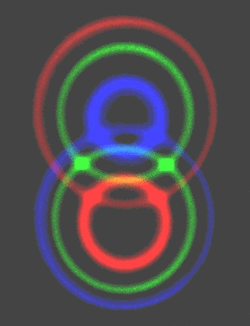Recycling Quantum Weirdness

To send a message using an unbreakable quantum code, you need quantum entanglement–a kind of long-distance connection between two physically separated particles. Researchers have dreamed up many other uses for quantum entanglement, including computers that use quantum states instead of ones and zeros. All such schemes destroy the entanglement that they process. But in the 25 October PRL a team shows that one pair of entangled particles can be used again and again to “catalyze” certain “reactions” between other entangled pairs because it is returned unchanged. With such recycling, maneuvers in quantum computing or cryptography might require fewer entangled pairs in order to operate.
Entanglement is an important aspect of quantum weirdness. Two entangled particles exist in a single quantum state even though one measures them as separate particles at different locations. They are correlated like two coins which somehow always come out opposite one another, even though each coin flip is completely random by itself. For example, researchers can create a pair of photons in which one photon is horizontally polarized and the other vertically polarized, but in which they can’t predict the state of a specific photon. To send a secret message, pairs of such photons are sent so that one photon goes to the sender (usually known as Alice), and the other goes to the receiver (Bob). If each person performs a series of measurements on the photons that come their way–and if Alice gives some non-coded instructions to Bob–the two can exchange a secret series of ones and zeros.
Many quantum information schemes have been proposed which destroy entanglement, including schemes for sending coded messages (quantum cryptography), transmitting an unknown quantum state (teleportation), and making quantum computation feasible (quantum error correction). Most of these schemes require fully entangled pairs of photons or other particles. One way to obtain such states is to “concentrate” partially entangled pairs: Before they exchange the message, Alice and Bob might perform measurements on combinations of partially entangled particles they receive and generate a smaller set of fully entangled pairs. But this procedure leaves some particle pairs “unentangled,” so they are wasted.
According to a new scheme proposed by Daniel Jonathan and Martin Plenio of Imperial College, University of London, the efficiency of entanglement concentration can be improved if Alice and Bob share an extra pair of partially entangled particles prepared in a special “catalyst” state. Like a chemical catalyst, this extra pair allows previously impossible entanglement “reactions” to take place, while the catalyst remains unaffected by the process. Alice and Bob can apply the catalyst to each partially entangled pair and convert more of them to full entanglement than they could without the catalyst, so they waste fewer pairs.
Besides providing another way to create entangled states for Alice and Bob, the new scheme may help researchers find new ways to manipulate quantum entanglement and possibly address some of the remaining questions about its fundamental nature. As Paul Kwiat of Los Alamos National Laboratory in New Mexico observes, “This certainly opens the way to lots of other interesting possibilities” for manipulating entanglement.
–Robert Garisto
Robert Garisto is an Assistant Editor for Physical Review Letters.


